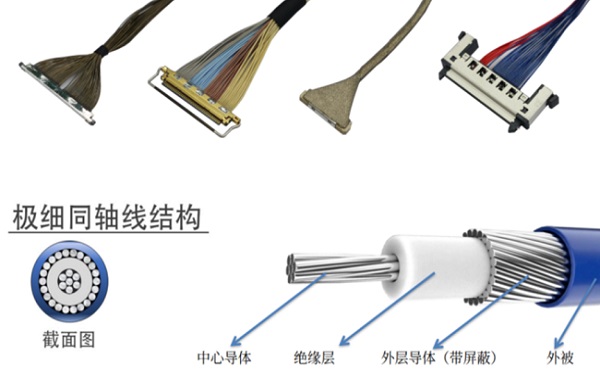Categorization:Harness Component

1.1 Conductor Losses
When the signal is in a high-frequency state, the skin effect causes the current to concentrate on the surface of the conductor, reducing the effective transmission area of the central conductor and increasing resistance accordingly. If the purity of the conductor material is not high or the surface is relatively rough, it will also further increase energy loss.1.2 Dielectric loss
The higher the loss tangent of the dielectric material, the greater the proportion of the signal converted into heat energy. The dielectric layer of extremely thin coaxial cable bundles is very thin, and if the material absorbs moisture or lacks stability, it will make the loss in high-frequency transmission more obvious.1.3 Impedance Mismatch and Reflection
High-speed interfaces such as MIPI, USB4, PCIe, etc., require accurate 50Ω or 90Ω differential impedance. If the impedance between the cable and the connector or PCB is not consistent, it will cause signal reflection, increased standing wave, and resulting in loss. Small structural errors, bends, and poor welding may cause the impedance to deviate from the design value.1.4 Mechanical Factors and Environmental Impact
Excessive bending and compression can alter the coaxial geometry, damaging the designed impedance. Changes in temperature and humidity can also cause the performance of the medium material to drift, leading to changes or deterioration in transmission characteristics.1.5 Blocking Insufficiency and Crosstalk
If the shielding layer density is insufficient or the grounding is not ideal, external electromagnetic interference is easy to enter the harness. At the same time, when the wiring is dense inside the module, crosstalk may occur between adjacent harnesses, leading to a decrease in signal quality.
Solution and Optimization Ideas
2.1 Material and Structure Optimization
Choose high-purity copper or silver-plated conductors to reduce conductor loss; use low-loss media such as PTFE, FEP, or foam structures to reduce medium loss; enhance shielding coverage to improve anti-interference ability.2.2 Impedance Control and Connection Technology Optimization
By strictly controlling the conductor diameter, dielectric thickness, and concentricity to ensure impedance stability; using precision connectors and optimizing the crimping or welding methods to avoid significant impedance突变 in the connection area.2.3 Standardization of the Use Process
Avoid sharp angle bends and adhere to the minimum bending radius; maintain proper spacing in wiring to reduce crosstalk; for long-distance or high-bandwidth links, consider adding equalizers or retimers to compensate for signal attenuation.2.4 System-level design coordination
Signal integrity simulation is conducted in the early design phase to evaluate loss risks in advance; link performance is verified through error rate testing, eye diagram analysis, and other methods to ensure transmission quality in actual use.
I amSuzhou Huichengyuan Electronic TechnologyLong-term focus on the design and customization of high-speed signal cable harnesses and ultra-fine coaxial cable harnesses, providing customers with reliable and stable high-speed interconnection solutions. For technical support or customization requirements, please contact Manager Yin.18913280527 (WeChat number)。